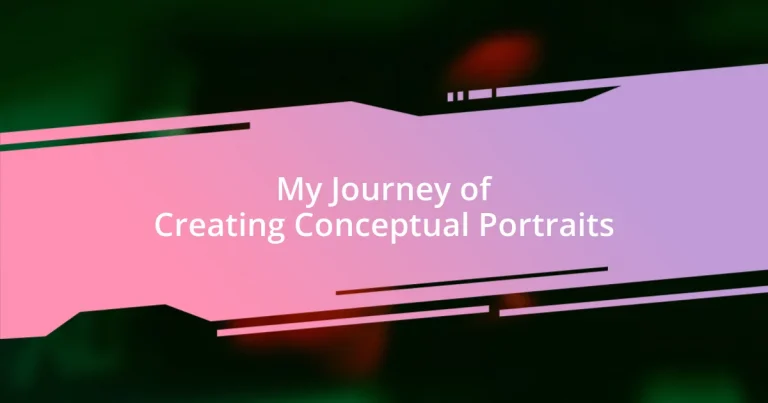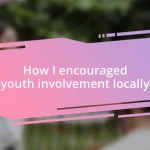Key takeaways:
- The initial inspiration for portraits stemmed from the emotional storytelling in photographs, highlighted by the influence of artists like Frida Kahlo.
- Choosing the right conceptual theme is crucial; it should evoke emotion and resonate personally with both the artist and audience.
- Patience, vulnerability, and an open mind lead to artistic growth, emphasizing that creativity is a journey of exploration and connection through shared stories.
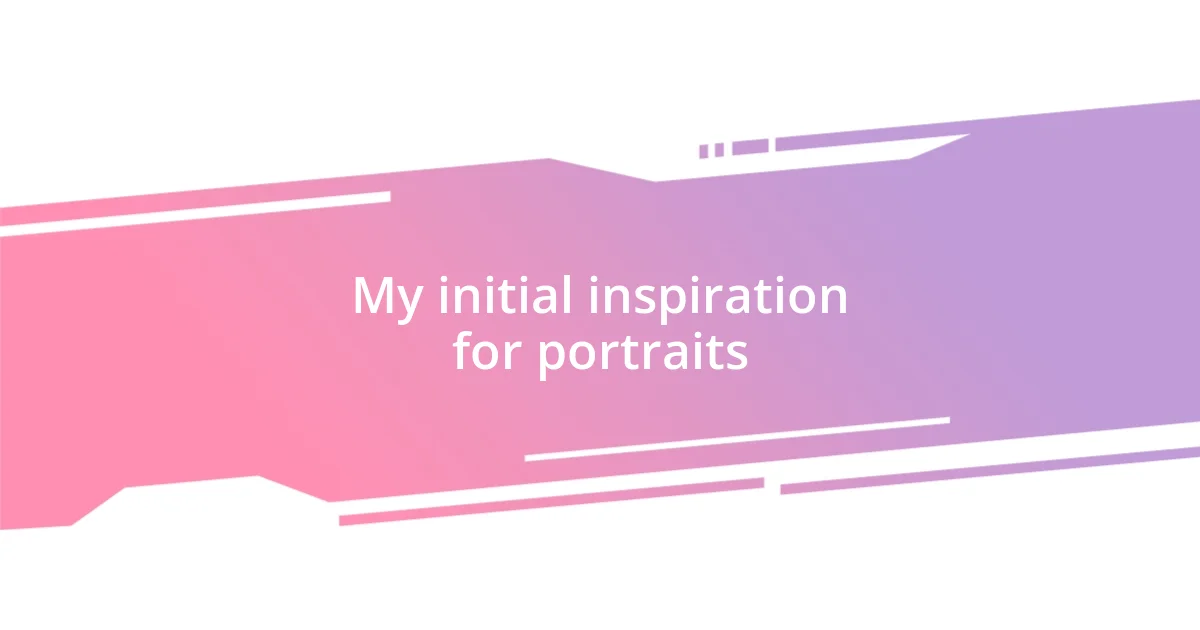
My initial inspiration for portraits
Growing up, I was captivated by the portraits in my grandmother’s photo album. Each face told a story, but what struck me most was how the eyes seemed to hold a universe of emotions and experiences. Have you ever looked at a picture and felt a connection that transcends time? That’s what drew me into this world of conceptual portraits.
I remember a particular moment during a high school art class when we studied the works of Frida Kahlo. Her self-portraits were not just about her likeness; they were raw expressions of her pain and joy. This revelation made me realize that portraits could capture identity in ways that words sometimes fail to do. How powerful is it to convey one’s inner world through a single image?
As I began experimenting with my own portraits, the concept of storytelling became a fundamental inspiration for me. I wanted to create images that resonated with viewers, making them feel a spectrum of emotions. I often ask myself, “What story is my subject trying to tell?” This question drives my creative process, pushing me to look deeper than the surface.
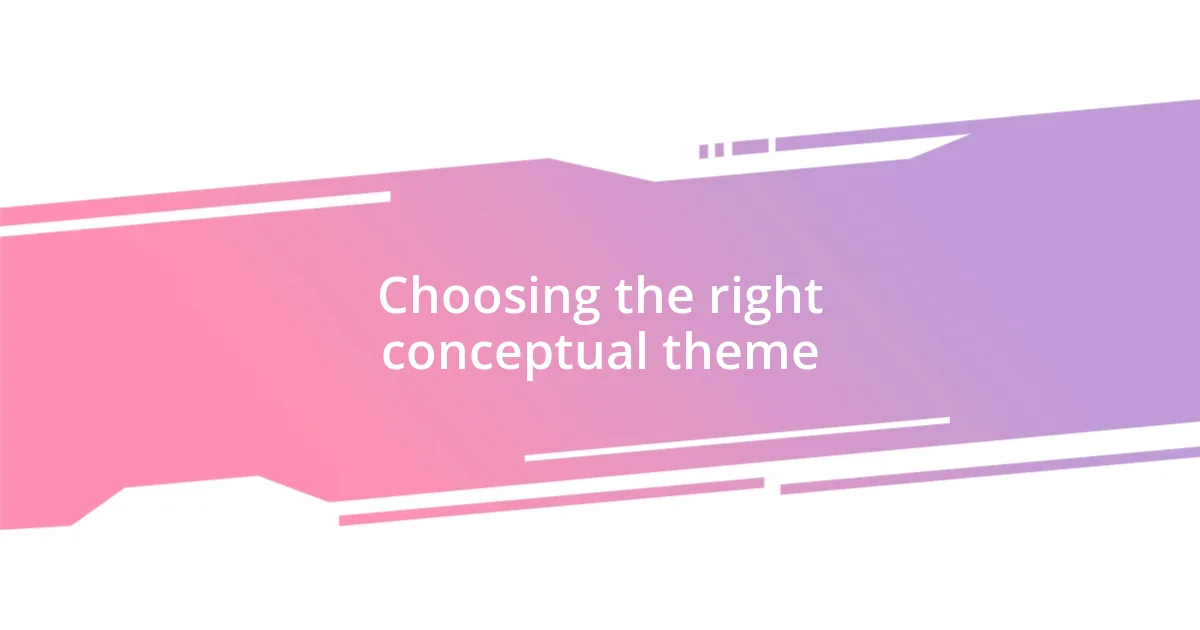
Choosing the right conceptual theme
Choosing the right conceptual theme can make or break a portrait. I often reflect on my early experiences when I was drawn to themes that resonated on a personal level. For instance, I once chose to explore the theme of “solitude.” The result was a hauntingly beautiful image that didn’t just show the subject but rather encapsulated the essence of being alone. To me, the theme should not only represent your subject but also evoke emotion in the viewer.
When selecting a theme, I find it helpful to brainstorm ideas that spark something within me. There was a time when I was inspired by the concept of “dualities,” showcasing contrasting emotions like joy and sorrow within a single frame. This exploration led to a series of portraits that profoundly highlighted the complexities of human nature. Have you considered how your own experiences inform the themes you choose? In my journey, intertwining personal narrative and universal concepts has been incredibly rewarding.
In the end, the chosen theme should resonate with both you and your audience. It’s about finding that exciting balance where personal expression meets universal relatability. I remember feeling a rush of excitement the first time a viewer connected deeply with a theme I had chosen, turning my artistic vision into a shared experience. This is the magic that comes from selecting the right conceptual theme.
| Criteria | Examples |
|---|---|
| Theme Type | Solitude, Dualities |
| Emotion Evoked | Loneliness, Complexity |
| Personal Connection | Reflective, Resonant |

Selecting and preparing your subjects
When selecting subjects for conceptual portraits, I often think about the emotional depth that each person can bring to the canvas. It’s not just about finding someone to photograph; it’s about discovering a connection that makes the photo resonate. I recall one experience where, during a casual gathering, I chatted with a friend about her struggles. Little did I know that our conversation would lead to a powerful portrait capturing her journey through resilience. This moment solidified for me the importance of understanding my subjects beyond the surface.
To help narrow down my subjects, I follow a few guidelines:
- Emotional Authenticity: Look for individuals who can express genuine emotions.
- Personal Backstory: Consider subjects with compelling narratives that can influence the image.
- Mutual Comfort: Ensure both you and your subject feel at ease; this fosters a more natural portrayal.
- Visual Impact: Think about how physical characteristics can enhance the conceptual theme.
- Willingness to Collaborate: Choose subjects who are open to sharing their stories and ideas with you.
By carefully selecting and preparing my subjects in this way, I ensure that every portrait tells a story that captivates and resonates with viewers on a deeper level.
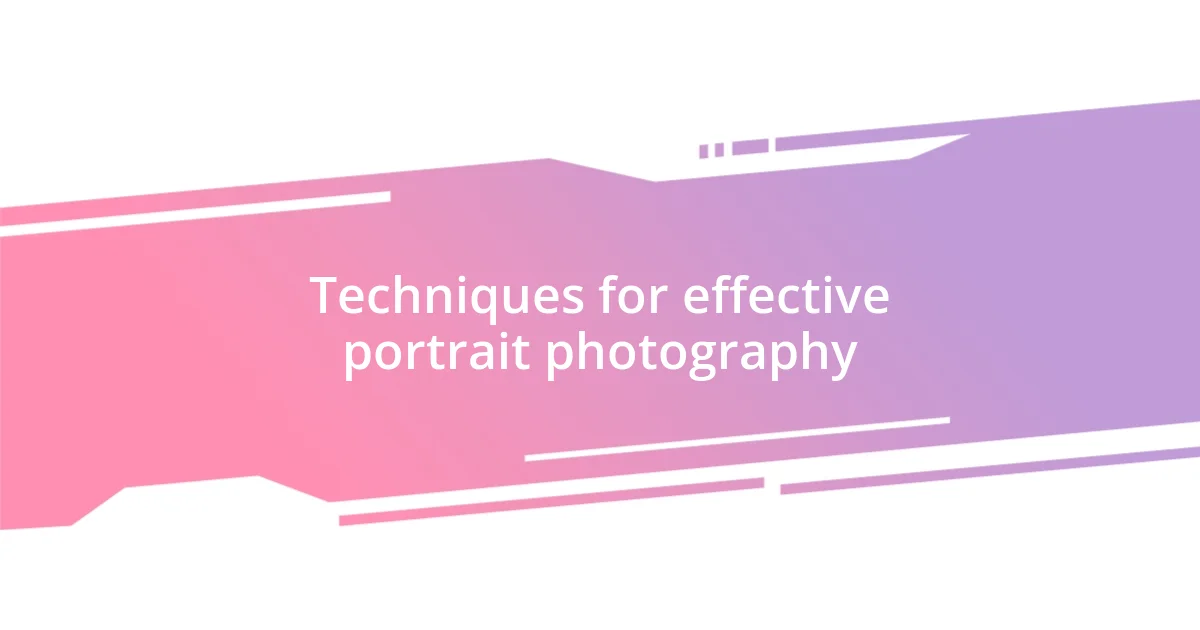
Techniques for effective portrait photography
When it comes to effective portrait photography, lighting is crucial. I often find myself experimenting with natural light during golden hour, the period just after sunrise or before sunset. This soft, warm light creates a beautiful glow on the subject’s skin, enhancing the emotional tone of the portrait. Have you ever noticed how your mood changes with the light around you? Capturing that emotional quality in your subjects can transform a simple photograph into something profound.
Another technique that has significantly impacted my work is the use of depth of field. By focusing on the subject and intentionally blurring the background, I draw the viewer’s attention to the nuances of expression and emotion within the frame. I remember one session where I shot a friend against a bustling street backdrop; by using a wide aperture, I isolated her completely, emphasizing her contemplative gaze amidst the chaos. It made me realize how much a simple adjustment can elevate the storytelling aspect of a portrait.
Lastly, I’ve found that directing my subjects thoughtfully can really make a difference. Instead of just snapping a shot, I guide them into poses that feel comfortable while also aligning with the conceptual theme. I recall a portrait of a dancer; I encouraged her to express her movement even when still. The resulting image sparkled with energy and told a story of strength and grace. Have you ever tried directing your subjects to reflect their inner world? The most captivating portraits often emerge from this collaborative process.
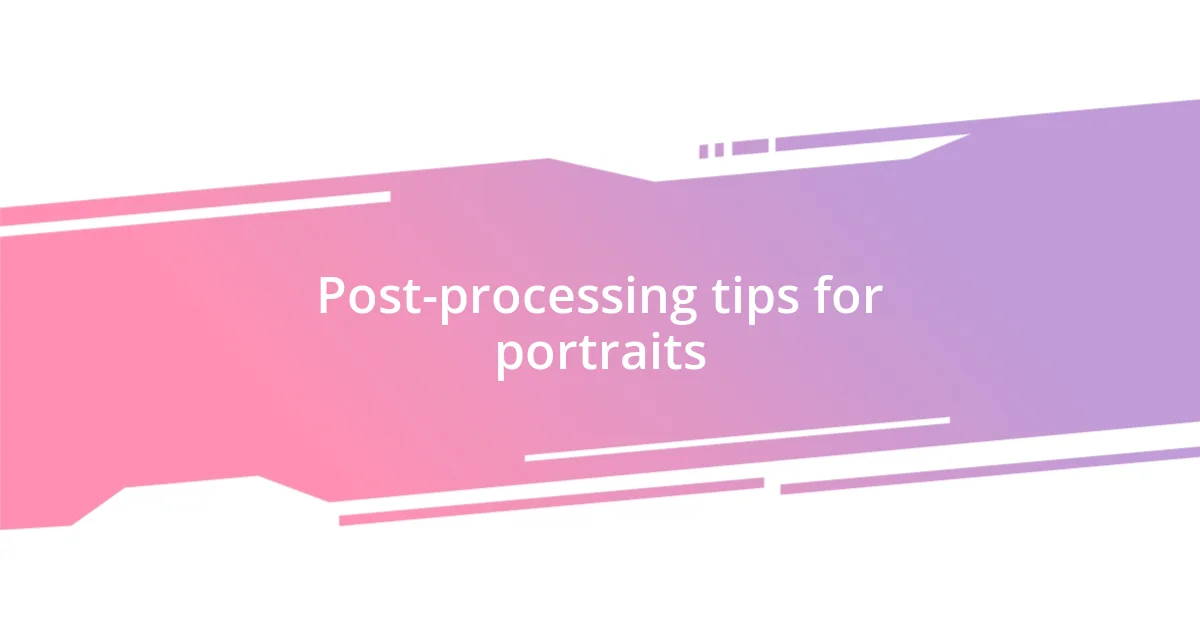
Post-processing tips for portraits
Post-processing can be a game-changer for portraits, allowing you to refine and elevate your work to match your vision. One of my go-to techniques is adjusting the contrast and brightness. I remember a portrait I took of a friend that initially felt flat; a little boost in contrast brought out the rich textures of her skin and the subtleties in her expression, transforming it into a vibrant portrayal of her personality. Have you ever felt a photo suddenly come to life with just a few tweaks?
Color grading is another essential step I enjoy delving into, as it sets the mood and tone of the image. When I was working on a conceptual portrait inspired by nostalgia, I played with warmer tones to evoke feelings of warmth and comfort. This decision wasn’t just aesthetic; it enhanced the storytelling aspect of the image. Have you explored the impact of color on your portraits? The subtle emotional undertones they can communicate are truly remarkable.
Lastly, don’t underestimate the power of small details. I often zoom in during post-processing to clean up distractions that might pull the viewer’s focus away from the subject. For instance, in a recent portrait featuring a subject lost in thought, I noticed a stray hair on her face that distracted from her expression. With just a few clicks, I removed it, allowing her contemplative gaze to shine through. It’s amazing how these little adjustments can pose profound impacts on the overall narrative. What small changes have made the biggest difference in your images?
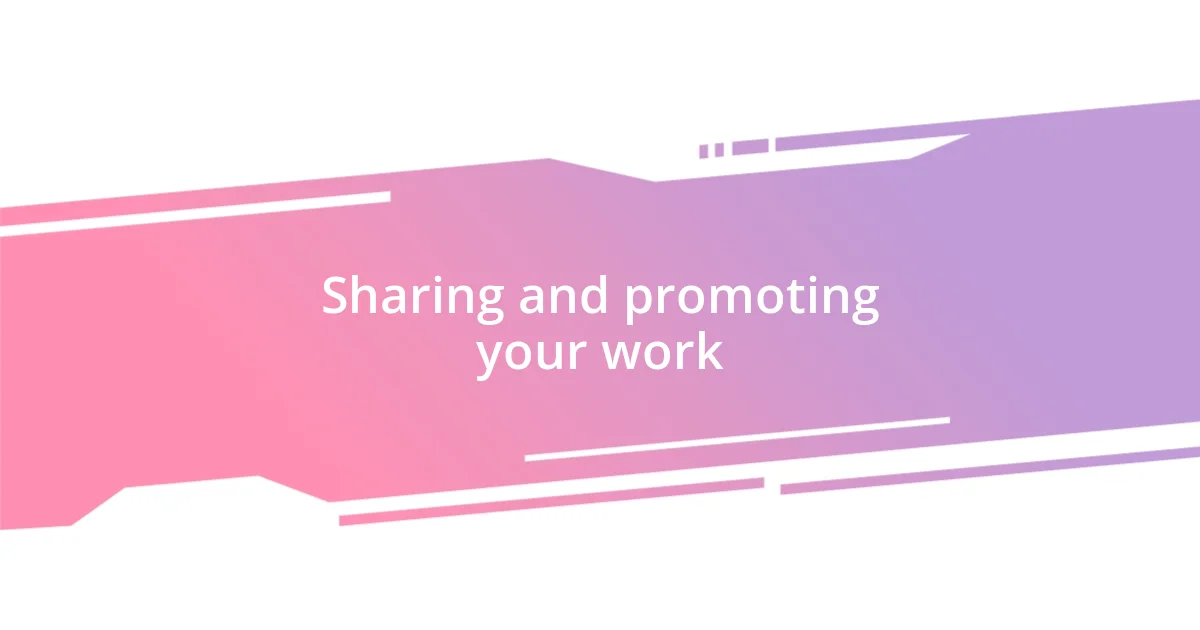
Sharing and promoting your work
Sharing your work is essential in this digital age, and I can’t stress enough the importance of choosing the right platform. Social media has become my playground for displaying conceptual portraits. Each time I post an image, I feel a mix of excitement and vulnerability, wondering how it will resonate with others. It’s incredible to see comments and shares that spark conversations about the themes I crafted. Have you experienced that thrill when the audience connects with your vision?
I also love participating in online photography communities. They provide a space not only to share my portraits but to receive valuable feedback. One memorable critique I received on a portrait made me rethink my approach to storytelling within my images. This showed me how engaging with others can inspire growth. Isn’t it fascinating how a single conversation can shift your perspective?
Lastly, I often think about the power of art shows or local exhibitions. Last year, I decided to showcase a series of portraits centered around identity. The experience was both nerve-wracking and exhilarating; hearing viewers’ interpretations of my work was eye-opening. It reinforced the idea that sharing isn’t just about displaying images; it’s about unveiling emotions and starting dialogues. Have you thought about how presenting your art can create connections far beyond the frame?
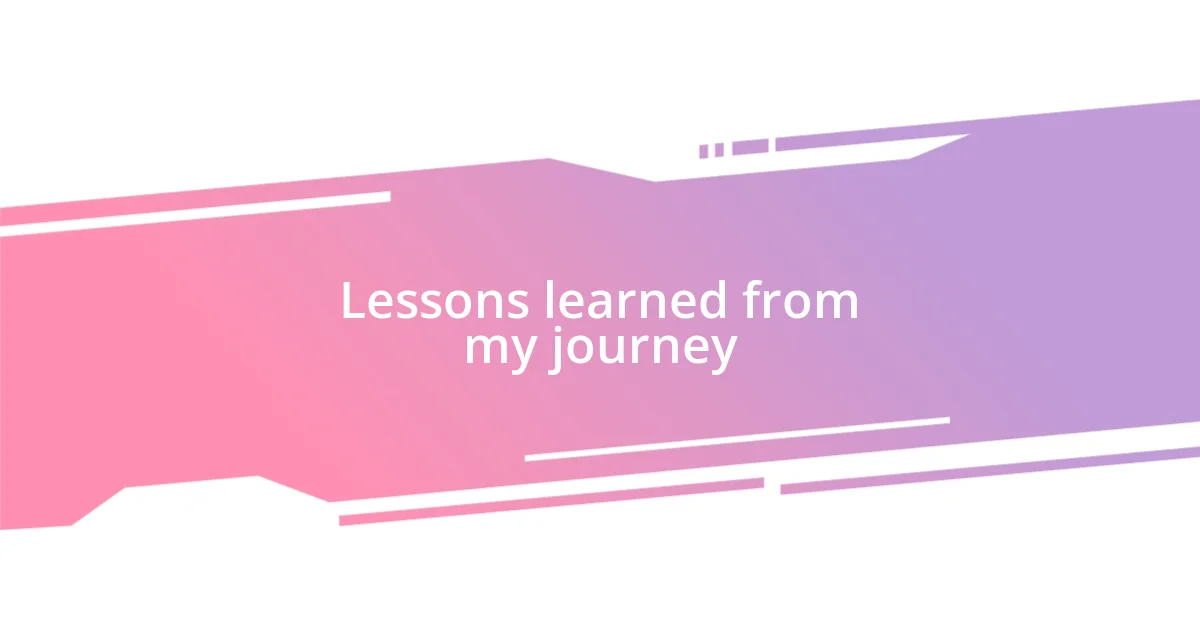
Lessons learned from my journey
Reflecting on my journey, one of the most significant lessons I’ve learned is the importance of patience during the creative process. There were times when I felt frustrated, especially when an idea didn’t translate well to my camera. I remember a specific instance when a shoot did not go as planned, and instead of getting discouraged, I took a step back, allowing myself the time to rework the concept. This not only led to a better result, but it also reminded me that creativity is often about trial and error. Have you ever found that stepping away can lead you to solutions you hadn’t considered before?
Another key realization has been the power of vulnerability in my portraits. I used to shy away from sharing my personal stories, thinking they wouldn’t resonate with others. However, when I finally opened up in a project that explored themes of loss and healing, the response was overwhelmingly positive. I recall the warmth of a stranger’s message thanking me for sharing something so intimate; it made me realize that our stories connect us on a deeper level. How often do we underestimate the impact of being genuinely ourselves?
Lastly, I’ve embraced the idea that art is an evolving journey. There was a time when I felt boxed in by my style, but as I experimented more, I discovered new techniques and inspirations that transformed my work. I vividly remember an unexpected collaboration with a dancer that pushed my conceptual boundaries and led to a series of images that felt truly alive. It illuminated for me the fact that growth comes from exploration, and that every experience is a stepping stone. Have you experienced a moment where breaking your own rules led to unexpected creativity?












